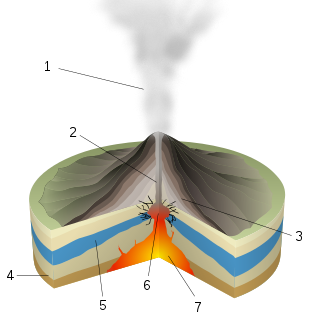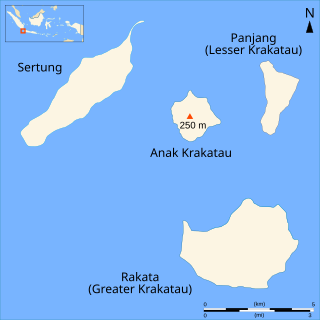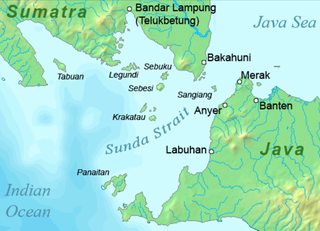Related Research Articles

Krakatoa, also transcribed Krakatau, is a caldera in the Sunda Strait between the islands of Java and Sumatra in the Indonesian province of Lampung. The caldera is part of a volcanic island group comprising four islands. Two, Lang and Verlaten, are remnants of a previous volcanic edifice destroyed in eruptions long before the infamous 1883 eruption; another, Rakata, is the remnant of a much larger island destroyed in the 1883 eruption.

Novarupta is a volcano that was formed in 1912, located on the Alaska Peninsula on a slope of Trident Volcano in Katmai National Park and Preserve, about 290 miles (470 km) southwest of Anchorage. Formed during the largest volcanic eruption of the 20th century, Novarupta released 30 times the volume of magma of the 1980 eruption of Mount St. Helens.

A phreatic eruption, also called a phreatic explosion, ultravulcanian eruption or steam-blast eruption, occurs when magma heats ground water or surface water. The extreme temperature of the magma causes near-instantaneous evaporation of water to steam, resulting in an explosion of steam, water, ash, rock, and volcanic bombs. At Mount St. Helens in Washington state, hundreds of steam explosions preceded the 1980 Plinian eruption of the volcano. A less intense geothermal event may result in a mud volcano.

Rakata, also called Greater Krakatau, is a partially collapsed and uninhabited stratovolcano on the Indonesian island of Krakatoa in the Sunda Strait between the islands of Sumatra and Java. Standing 813 m (2,667 ft) tall, it was the largest and southernmost of three volcanoes that formed the island Krakatoa and the only one not totally destroyed in the 1883 eruption. Rakata is the last remnant of the original island prior to its destruction. However, Rakata did lose its northern half in that eruption, leaving just its southern half. The exposed cliff is quite striking visually, partially of a large exposed dike terminating in a large lenticular extrusion at the middle of the almost vertical cliff. The feature has been called "the Eye of Krakatoa."

Anak Krakatoa is a volcanic island in Indonesia. On 29 December 1927, Anak Krakatoa first emerged from the caldera formed in 1883 by the explosive volcanic eruption that destroyed the island of Krakatoa. There has been sporadic eruptive activity at the site since the late 20th century, culminating with a large underwater collapse of the volcano that caused a deadly tsunami in December 2018. There has been subsequent activity since. Due to its young age, the island is one of several in the area that are of interest to, and the subject of extensive study by, volcanologists.

Krakatoa: The Last Days is a BBC Television docudrama that premiered on 7 May 2006 on BBC One. The program is based upon four eyewitness accounts of the 1883 eruption of Krakatoa, an active stratovolcano between the islands of Sumatra and Java, present day Indonesia.
Perboewatan was one of the three main volcanic cones on the island of Krakatoa, in the Sunda Strait, in Indonesia. It was the lowest and northernmost of the cones. Perboewatan was completely destroyed during the 1883 eruption; the caldera is approximately 820 feet (250 m) deep at its former location.
Danan was one of the three volcanic cones on the island of Krakatoa, in the Sunda Strait, in Indonesia. It stood 450 metres (1,480 ft), lay in the central area of the island, and may have been a twin volcano. Danan was almost entirely destroyed in the 1883 eruption of Krakatoa; only a rocky islet named Bootsmansrots remains of it.

Sebesi is an Indonesian island in the Sunda Strait, between Java and Sumatra, and part of the province of Lampung. It rises to a height of 844 metres (2,769 ft) and lies about 12 kilometres (7.5 mi) north of the Krakatoa Archipelago; it is the closest large island to Krakatoa, about the same area and height as the remnant of Rakata. Like Krakatoa, it too is volcanic, although no dated eruptions are known. Unlike the Krakatoa Archipelago, Sebesi has permanent streams and is inhabited. Habitation is concentrated most heavily on the northern and eastern coasts of the island.

Rogier Diederik Marius Verbeek was a Dutch geologist and natural scientist.

The Smithsonian Institution's Global Volcanism Program (GVP) documents Earth's volcanoes and their eruptive history over the past 10,000 years. The mission of the GVP is to document, understand, and disseminate information about global volcanic activity.

Panaitan is an island in the Sunda Strait, between Java and Sumatra, and in the Indonesian province of Banten. It is the largest island in the strait, and is located near the westernmost tip of Java. Like the nearby Krakatoa, it too is volcanic in origin, although there are no known historic eruptions. The name 'Prince's Island' apparently is because the island was considered the property of Javan princes. Administratively, the island is a part of Pandeglang Regency.

Sebuku is an island in the Sunda Strait between Java and Sumatra. It is one of the larger islands in the strait and lies just 2.5 km (1.6 mi) to the north of Sebesi and 2.3 kilometres (1.4 mi) south of Sumatra. It is administratively part of South Lampung Regency, Lampung.

The 1883 eruption of Krakatoa in the Sunda Strait occurred from 20 May until 21 October 1883, peaking in the late morning hours of 27 August when over 70% of the island of Krakatoa and its surrounding archipelago were destroyed as it collapsed into a caldera.
Friedrich von Hollmann was an Admiral of the German Imperial Navy and Secretary of the German Imperial Naval Office under Emperor Wilhelm II.

Indonesia is a volcanically active country, containing numerous major volcanoes. It has the most volcanoes of any country in the world, with 76 volcanoes that have erupted at least 1,171 times in total within historical times. The Smithsonian Institution has 141 Indonesian entries in its volcano database. Indonesia has around 130 active volcanoes that are part of the Pacific Ring of Fire, and it has suffered the highest numbers of eruptions resulting in fatalities, damage to arable land, debris flows, tsunamis, lava domes, and pyroclastic flows. Indonesia's most active volcanoes are Kelut and Mount Merapi on the island of Java. The majority of Indonesia's volcano are located on a 3,000 km long chain called the Sunda Arc. Here, the subduction of the Indian Ocean crust underneath the Asian Plate produced most of these volcanoes.

Cornelis Andries Backer (1874–1963) was a Dutch botanist and pteridologist. He was born on 18 September 1874 in Oudenbosch and died on 22 February 1963 at Heemstede, The Netherlands. He stayed thirty years in the Dutch East Indies and did research on plant taxonomy on the islands of Java and Madura.

The Krakatoa Archipelago is a small uninhabited archipelago of volcanic islands formed by the Krakatoa stratovolcano located in the Sunda Strait, nestled between the much larger islands of Java and Sumatra. As of 2018, the archipelago consists of four main islands: Verlaten, Lang, Rakata, and the currently volcanically active Anak Krakatoa. Together, the islands are a part of the Indonesian island arc system, created by the northeastward subduction of the Indo-Australian Plate. As part of a dynamic volcanic system, the islands have been continuously reshaped throughout recorded history, most notably in the 1883 eruption of Krakatoa.

A volcanic tsunami, also called a volcanogenic tsunami, is a tsunami produced by volcanic phenomena. About 20–25% of all fatalities at volcanoes during the past 250 years have been caused by volcanic tsunamis. The most devastating volcanic tsunami in recorded history was that produced by the 1883 eruption of Krakatoa. The waves reached heights of 40 m (130 ft) and killed 36,000 people.
References
- ↑ Alfred, Ernst; Seward, A. C; Cambridge Books Online (2009), The New Flora of the Volcanic Island of Krakatau, Cambridge University Press, ISBN 978-0-511-70340-9
- ↑ Backer, C. A. (Cornelis Andries) (1929), The problem of Krakatao as seen by a botanist, C.A. Backer, retrieved 26 December 2018
- ↑ Rupert Furneaux (1964), Krakatoa, Englewood Cliffs, N.J Prentice-Hall, retrieved 26 December 2018
- ↑ Simkin, Tom; Fiske, Richard S (1983), Krakatau, 1883--the volcanic eruption and its effects, Smithsonian Institution Press, ISBN 978-0-87474-841-3
- ↑ Thornton, I. W. B. (Ian W. B.) (1996), Krakatau : the destruction and reassembly of an island ecosystem , Harvard University Press, ISBN 978-0-674-50568-1
- ↑
- Verbeek, R. D. M. (1884). "The Krakatoa eruption". Nature. 30 (757): 10–15. Bibcode:1884Natur..30...10V. doi: 10.1038/030010a0 . S2CID 5444712.
- ↑ Translation of material found in - Simkin, Tom; Fiske, Richard S (1983), Krakatau, 1883--the volcanic eruption and its effects, Smithsonian Institution Press, ISBN 978-0-87474-841-3
- ↑ Rogier Diederik Marius Verbeek (1885), Krakatau, Batavia Imprimerie de l'état, retrieved 26 December 2018
- ↑ Simkin, Tom; Fiske, Richard S (1983), Krakatau, 1883--the volcanic eruption and its effects, Smithsonian Institution Press, ISBN 978-0-87474-841-3
- ↑ Winchester, Simon (2003). Krakatoa: The Day the World Exploded, August 27, 1883. New York: HarperCollins. ISBN 0-06-621285-5.
- ↑ "Krakatau". YouTube . 30 November 2008. Archived from the original on 2021-12-15.
- ↑ "Anak Krakatoa from safer distance". YouTube . 25 March 2008. Archived from the original on 2013-07-22.
- ↑ "Mega Disasters - Krakatau's Revenge". YouTube . 25 October 2015. Archived from the original on 2021-12-15. Retrieved 8 November 2016.
- ↑ "Watch The Krakatoa Volcano Clip - How the Earth Was Made | HISTORY". history.com. Video Gallery at History.com.